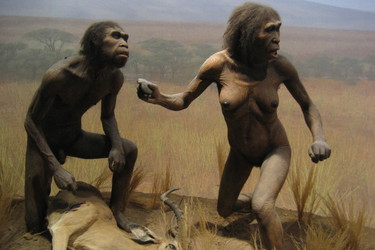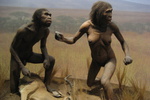Homo
Humans
- Homo sapiens (modern humans)
- Homo erectus

- Homo ergaster

- Homo rudolfensis

- Homo habilis

References
Bermudez de Castro, J.M., J. Arsuaga, E. Carbonell, A. Rosas, I. Martinez, and M. Mosquera. 1997. A hominid from the lower Pleistocene of Atapuerca, Spain: possible ancestor to Neandertals and modern humans. Science 276:1392-1395.
Brown, P., T. Sutikna, M. J. Morwood, R. P. Soejono, Jatmiko, E. Wayhu Saptomo, and Rokus Awe Due. 2004. A new small-bodied hominin from the Late Pleistocene of Flores, Indonesia. Nature 431:1055-1061.
Caramelli, D., C. Lalueza-Fox, C. Vernesi, M. Lari, A. Casoli, F. Mallegni, B. Chiarelli, I. Dupanloup, J. Bertranpetit, G. Barbujani,and G. Bertorelle. 2003. Evidence for a genetic discontinuity between Neandertals and 24,000-year-old anatomically modern Europeans. Proceedings of the National Academy of Sciences (USA) 100(11):6593-6597.
Duarte, C., J. Maurício, P. B. Pettitt, P. Souto, E. Trinkaus, H. van der Plicht, and J. Zilhão. 1999. The early Upper Paleolithic human skeleton from the Abrigo do Lagar Velho (Portugal) and modern human emergence in Iberia. Proceedings of the National Academy of Sciences (USA) 96:7604-7609.
Harvati, K., S. R. Frost, and K. P. McNulty. 2004. Neanderthal taxonomy reconsidered: Implications of 3D primate models of intra- and interspecific differences. Proceedings of the National Academy of Sciences (USA) 101(5):1147-1152.
Kahn P. and A. Gibbons. 1997. DNA from an extinct human. Science 277:176-178.
Key, C. A. 2000. The evolution of human life history. World Archaeology 31:329-350.
Krings, M., A. Stone, R. W. Schmitz, , H. Krainitzki, M. Stoneking, and S. Päabo. 1997. Neandertal DNA sequences and the origin of modern humans. Cell 90:19-30.
Krings, M., H. Geisert, R. W. Schmitz, H. Krainitzki, and S. Päabo. 1999. DNA sequence of the mitochondrial hypervariable region II from the Neandertal type specimen. Proceedings of the National Academy of Sciences (USA) 96:5581-5585.
Lieberman, D. E., B. A. Wood, and D. R. Pilbeam. 1996. Homoplasy and early Homo: An analysis of the evolutionary relationships of H. habilis sensu stricto and H. rudolfensis. Journal of Human Evolution 30:97-120.
Morwood, M. J., R. P. Soejono, R. G. Roberts, T. Sutikna, C. S. M. Turney, K. E. Westaway, W. J. Rink, J.-X. Zhao, G. D. van den Bergh, Rokus Awe Due, D. R. Hobbs, M. W. Moore, M. I. Bird, and L. K. Fifield. 2004. Archaeology and age of a new hominin from Flores in eastern Indonesia. Nature 431:1087-1091.
Ovchinnikov, I. V., A. Gotherstrom, G. P. Romanova, V. M. Kharitonov, K. Liden, and W. Goodwin. 2000. Molecular analysis of Neanderthal DNA from the northern Caucasus. Nature 404:490-493.
Schillaci, M. A. and J. W. Froehlich. 2001. Nonhuman primate hybridization and the taxonomic status of Neanderthals. American Journal of Physical Anthropology 115(2):157-166.
Schwartz, J. H. and I. Tattersall. 2002. The Human Fossil Record. Volume 1: Terminology and Craniodental Morphology of Genus Homo (Europe). Wiley, New York. 400 pp.
Spoor, F. , M. G. Leakey, P. N. Gathogo, F. H. Brown, S. C. Antón, I. McDougall, C. Kiarie, F. K. Manthi, and L. N. Leakey. 2007. Implications of new early Homo fossils from Ileret, east of Lake Turkana, Kenya. Nature 448:688-691.
Swisher, C. C., W. J. Rink, S. C. Anton, H. P. Schwartz, G. H. Curtis, A. Suprijo, Widiasmoro. 1996. Latest Homo erectus of Java: Potential contemporaneity with Homo sapiens in southeast Asia. Science 274:1870-1874.
Tattersall, I. 1995. The Last Neanderthal: The Rise, Success, and Mysterious Extinction of Our Closest Human Relatives. Macmillan, New York.
Tattersall, I. And J. H. Schwartz. 1999. Hominids and hybrids: The place of Neanderthals in human evolution. Proceedings of the National Academy of Sciences (USA) 96:7117-7119.
Wood, B. and M. Collard. 1999. Anthropology - The human genus. Science 284:65-71.
Wood, B. and M. Collard. 1999. The changing face of genus Homo. Evolutionary Anthropology 8:195-207.
Information on the Internet
- talk.origins archives:
- The Smithsonian Institution Human Origins Program. In search of what makes us human.
- Institute of Human Origins. Arizona State University.
- Human Origins. George Washington University.
- Journal of Human Evolution
- Flores Man Special. Nature special on the discovery of a new species of tiny human, which lived on the remote Indonesian island of Flores just 18,000 years ago.
- Skull fuels Homo erectus debate. BBC News.
- Ken Reeser's Hominid Evolution from Australopithecus to Cro-Magnon.
- Kevin L. Callahan's Anthropology Human Origins Website
- D. I. Loizos' Human Prehistory: An Exhibition
- Peter Brown's Australian & Asian Palaeoanthropology
- The Fossil Evidence for Human Evolution in China. Center for the Study of Chinese Prehistory.
- The Neanderthal Museum
- In Search of Human Origins. National Geographic Society.
- The Long Foreground: Human Prehistory. A student module from Wahington State University.
- Human Evolution. Handprint: Ancestral Lines.
- Hominid Evolution. Yale-New Haven Teachers Institute.
- Charles Darwin: The Descent of Man. Full text from the Secular Web Library.
Title Illustrations

| Scientific Name | Homo ergaster |
|---|---|
| Location | American Museum of Natural History, New York, New York, USA |
| Specimen Condition | Model |
| Source | NYC - AMNH: Spitzer Hall of Human Origins - Homo Ergaster |
| Source Collection | Flickr |
| Image Use |
 This media file is licensed under the Creative Commons Attribution-NonCommercial-NoDerivs License - Version 2.0. This media file is licensed under the Creative Commons Attribution-NonCommercial-NoDerivs License - Version 2.0.
|
| Copyright | © 2007 Wally Gobetz |
About This Page
Page copyright © 1999
 Page: Tree of Life
Homo. Humans.
The TEXT of this page is licensed under the
Creative Commons Attribution-NonCommercial License - Version 3.0. Note that images and other media
featured on this page are each governed by their own license, and they may or may not be available
for reuse. Click on an image or a media link to access the media data window, which provides the
relevant licensing information. For the general terms and conditions of ToL material reuse and
redistribution, please see the Tree of Life Copyright
Policies.
Page: Tree of Life
Homo. Humans.
The TEXT of this page is licensed under the
Creative Commons Attribution-NonCommercial License - Version 3.0. Note that images and other media
featured on this page are each governed by their own license, and they may or may not be available
for reuse. Click on an image or a media link to access the media data window, which provides the
relevant licensing information. For the general terms and conditions of ToL material reuse and
redistribution, please see the Tree of Life Copyright
Policies.
Citing this page:
Tree of Life Web Project. 1999. Homo. Humans. Version 01 January 1999 (temporary). http://tolweb.org/Homo/16418/1999.01.01 in The Tree of Life Web Project, http://tolweb.org/








 Go to quick links
Go to quick search
Go to navigation for this section of the ToL site
Go to detailed links for the ToL site
Go to quick links
Go to quick search
Go to navigation for this section of the ToL site
Go to detailed links for the ToL site